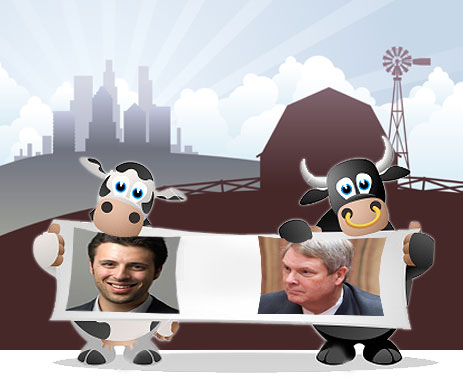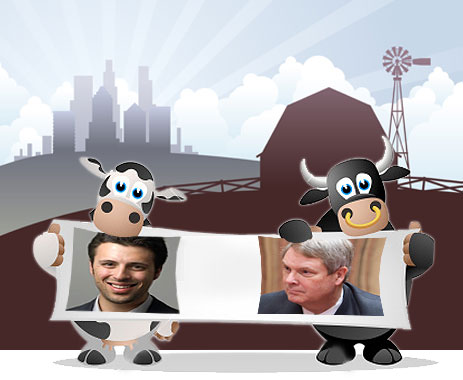 Carried away: Ezra Klein and Tom Vilsack ride an imaginary “raft of subsidies.” This week, an interesting — and, I think, bizarre — argument broke out between Washington Post political blogger Ezra Klein and USDA Secretary Tom Vilsack. The topic was whether rural residents deserve what Klein called a “raft of subsidies,” when in fact, “we still need cities.” Klein’s contributions to the debate were widely hailed as “brilliant” and Vilsack’s were widely deplored (see here and here); but I was left wondering what precisely the two were arguing about — and whether either one of them actually knew what he was talking about.
Carried away: Ezra Klein and Tom Vilsack ride an imaginary “raft of subsidies.” This week, an interesting — and, I think, bizarre — argument broke out between Washington Post political blogger Ezra Klein and USDA Secretary Tom Vilsack. The topic was whether rural residents deserve what Klein called a “raft of subsidies,” when in fact, “we still need cities.” Klein’s contributions to the debate were widely hailed as “brilliant” and Vilsack’s were widely deplored (see here and here); but I was left wondering what precisely the two were arguing about — and whether either one of them actually knew what he was talking about.
To me, the debate reflects rather naive prevailing beliefs on the relationship between town and country. Cities and rural areas aren’t locked in a death match for precious resources; rather, their relationship is symbiotic. Healthy cities need healthy rural areas — and vice versa. Right now, in a large sense, we have neither.
Instead of a smart dissection of that dilemma, what did we get from Klein and Vilsack? Klein opened things up with a short post on the ongoing importance of cities. Citing Ed Glaeser‘s new book, Triumph of the City, Klein draws out the fairly standard insight that cities remain important, because face-to-face contact turns out to be better at generating innovation than telecommuting. (They remain important for a lot of other reasons, too). From there, Klein concludes that cities “make us smarter, more productive and more innovative. To put it plainly, they make us richer. And the evidence in favor of this point is very, very strong.” Fair enough. But then he adds this non sequitur:
But it would of course be political suicide for President Obama to say that part of winning the future is ending the raft of subsidies we devote to sustaining rural living. [Emphasis added.]
The way I read this, Klein is arguing that the future health of cities requires the end of federal subsidies to rural living, of which there are a raft. Um …. OK. Lots going on here. Before we even get to Vilsack’s response, I’ve got to do some unpacking.
First of all, when I think of what holds back cities, I don’t think about, say, the farm fields of Iowa or the shale gas regions of rural Pennsylvania and New York. What I do think of is suburbia, and the way U.S. cities have been structured for half a century around the car — specifically, around moving people via private transportation pods through a web of low-density suburbs that surround cities, on publicly funded roads.
I would call the massive public investment in sprawl infrastructure over the past half century, which got yet another boost from the recent ill-fated housing boom, the tragedy of cities as we head into a carbon-constrained, pricey-oil future. Our vast, sprawling suburbs are not going to be easy to dismantle going forward — built environments don’t transform themselves overnight. The phenomenon of asset inertia arises: we are compelled to use (and maintain) existing infrastructure merely because it’s there and we can’t imagine finding sufficient resources to replace it, long after it makes sense (if it ever did). Mass transit works beautifully in dense environments like Manhattan; but not so well in, say, the fourth suburban ring outside of Phoenix or Orlando.
The post-war explosion of suburbia that’s strangling our cities was not a pure expression of consumer will; it represented a mass mobilization of government policy and cash. Take, for example, Detroit, a high-flying, if woefully economically homogeneous, city in the years just after World War II. As I showed in my profile of that city for our urban-ag special series last year, Detroit’s decline began right after its postwar peak; the auto industry began moving factories to the suburbs in the 1950s. State and regional policymakers complied, doling out, yes, a raft of subsidies for sprawl in the form of roads, sewage services, and corporate tax giveaways for locating in far-flung suburbs. Their efforts continued in the new century, as this 2005 report from the Michigan Land Use Institute makes depressingly clear.
Then, of course, there are all the subsidies to cheap oil on which suburban living depends — everything from direct giveaways to oil companies to lax enforcement of environmental rules (see the Deepwater Horizon calamity) to the free ride for carbon emissions to foreign military adventures to keep oil flowing globally. Furthermore, it’s important to remember that sprawl doesn’t just menace the future viability of our cities; it’s also devouring rural farmland, which suburbia colonizes in its flight from the city, as American Farmland Trust explains.
In short, whatever threat rural areas pose to the future of our cities, it simply can’t compare to the dead weight placed on top of them by 50 years of suburbanization. With that settled, let’s move on to that “raft of subsidies we devote to sustaining rural living.” Just how much are we doling out to feather the nests of the country mice among us (of which I am now one)?
Over on the Daily Yonder, Bill Bishop obliterates the idea that rural residents are somehow sucking the life out of cities by sucking in all manner of subsidies. He shows that per-capita federal spending is actually slightly higher in metro counties than in non-metro counties. As for “community spending” from the federal government — housing, community assistance, environmental protection, regional development, and transportation, the kind of expenditures that directly impact “rural living” — metro residents get about 50 percent more than non-metro residents on a per-capita basis.
What Klein’s complaint really comes down to, I suppose, is the whole vexed issue of farm subsidies. But as the Center for Rural Affairs’ Brian Depew shows on Civil Eats, farm subsidies tend to flow to a relatively few industrial-scale operations. And the benefits are not widely distributed. According to Depew, his group’s research shows that the “USDA spent nearly twice as much to subsidize just the 20 largest farms in each of 13 leading farm states … as it invested in rural-development programs to create economic opportunity for the 3 million people living in 1,400 towns in the 20 most-struggling rural counties in the same 13 states.” In other words, farm subsidies don’t prop up “rural living”; they underwrite the kind of industrial farming that’s been hollowing out rural areas for half a century.
Indeed, there’s strong evidence that the kind of industrial-scale commodity farming promoted by the USDA extracts wealth from rural communities. In this 2006 column, I teased out the work of community-development researcher Ken Meter, which shows that farm subsidies often don’t even offset the losses that farmers incur from growing corn and soy for the global commodity market. In these cases, the real beneficiaries of farm subsidies aren’t farmers at all, but rather the large companies that sell them inputs and buy, process, and broker their corn and soy. A study [PDF] by Tufts researchers Tim Wise and Alicia Harvie reckons that by putting downward pressure on corn and soy prices, federal subsidies saved chicken producers $11.3 billion, pork processors $8.5 billion, and beef packers $4.5 billion in the 1997-2005 time frame. Producers of high-fructose corn syrup benefited too, to the tune of $2.2 billion, the researchers estimate. In other words, rather than generate economic activity in the countryside, farm subsidies mainly end up in the bank accounts of shareholders in a few big companies.
It’s also true that rural ethanol production benefits from all manner of federal subsidies and protections. But here, too, the economic boon for rural residents has been way overstated. Indeed, the ethanol industry is on the path to consolidating into a small number of large companies — not locally owned rural co-ops, but rather “integrated firms that have other revenue streams and contracted marketing plans.”
So, there’s no “raft of subsidies” that somehow “sustains rural living.” If only!
Into this muddled picture, enter Vilsack. Evidently the USDA chief read Klein’s piece as a “slam on rural America,” and had a staffer set up a phone conversation to hash out his differences with the blogger. What resulted is … just weird. In their conversation as recounted by Klein, Vilsack doesn’t challenge the “raft of subsidies” idea but instead argues that rural residents deserve a raft of subsidies based mainly on the fact that rural residents are more likely to serve in the military than urban residents. Huh?
As for Klein, he brings up the suburban issue — but in the oddest way possible. “I come from a suburb,” he tells Vilsack. “The people I knew had good values. My mother and father are good and hardworking people. But they don’t get subsidized because they’re good and hardworking people.” Um … OK — but then why are suburban residents subsidized? As I show above, the suburban lifestyle is in fact highly subsidized, and in a way that’s going to make it hard for decades to transform our cities into green and livable ones.
Vilsack, of course, neglects to challenge Klein on this point. Instead, he returns to the “military service piece.” And Klein goes on to pummel him more about those “heavily subsidized” rural residents. Sigh.
It was, in sum, a most unedifying conversation. As someone with a deep love and respect for urban and rural living, I urge both of these highly influential people to reconsider their cartoonish views of the relationship between cities and rural areas. I urge them both to read William Cronon’s magnificent Nature’s Metropolis: Chicago and the Great West, which beautifully illustrates how cities and their hinterlands essentially create each other. The urban can’t exist without the rural, and vice versa. Chicago would not exist as we know it if its residents hadn’t extracted massive amounts of wealth from the soil fertility of the surrounding countryside and from the labor of farmers. And what we now call the “corn belt” would still largely be wild prairie if not for the vast market for farm goods represented by Chicago and its traders.
Cities, of course, continue extracting resources from the countryside. In his interview with Vilsack, Klein declares that he spends just “6 or 7 percent of my paycheck” on food, but doesn’t pause to reflect on what hidden costs that cheap bounty impose on rural areas where food is grown. And the electricity that powers Klein’s computer likely stems from power sources including coal mines that flattened mountaintops in Appalachia, and natural gas extracted from rural areas using environmentally devastating hydrofracturing. Both sources permanently scar rural landscapes.
The task of policymakers is to create conditions for healthy, green cities and healthy, green rural areas. I can’t imagine how either can exist in isolation of the other. Vilsack’s agency still mainly promotes industrial agriculture, which has proven an awesome force for clearing the countryside of people and replacing them with energy-intensive machines and agrichemicals — generating cheap food that threatens public health in cities. Klein’s confused critique of USDA rural policy does little to advance the conversation.


